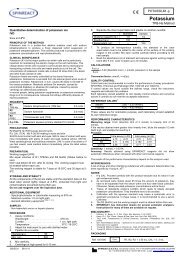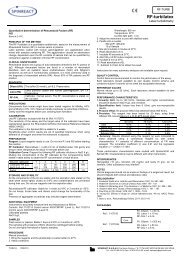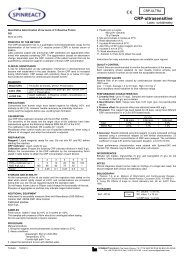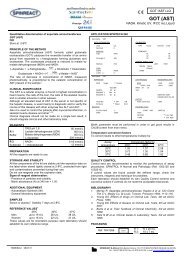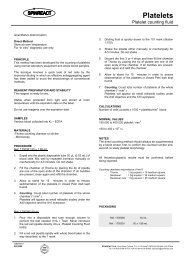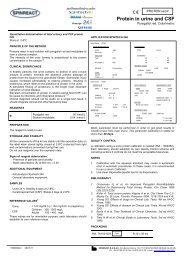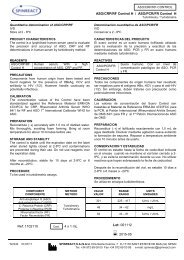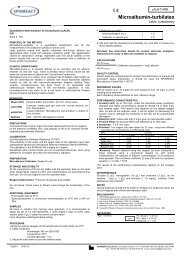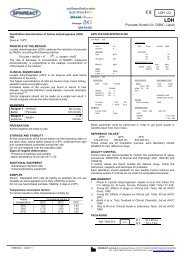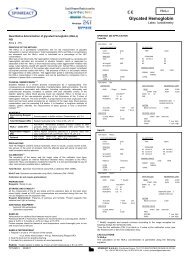Magnesium
Magnesium - Spinreact
Magnesium - Spinreact
- No tags were found...
You also want an ePaper? Increase the reach of your titles
YUMPU automatically turns print PDFs into web optimized ePapers that Google loves.
MAGNESIUM<br />
<strong>Magnesium</strong><br />
Xylidyl Blue. Colorimetric<br />
Quantitative determination of magnesium<br />
IVD<br />
Store at 2-8ºC<br />
PRINCIPLE OF THE METHOD<br />
<strong>Magnesium</strong> forms a coloured complex when reacts with Magon<br />
sulfonate in alkaline solution.<br />
The intensity of the color formed is proportional to the magnesium<br />
concentration in the sample 1 .<br />
CLINICAL SIGNIFICANCE<br />
<strong>Magnesium</strong> is the second more abundant intracellular cation of<br />
the human body after potassium, being essential in great number<br />
of enzymatic and metabolic processes.<br />
Is a cofactor of all the enzymatic reactions that involve the ATP<br />
and comprises of the membrane that maintains the electrical<br />
excitability of the muscular and nervous cells.<br />
A low magnesium level is found in malabsortion syndrome,<br />
diuretic or aminoglucoside therapy; hyperparathyroidism or<br />
diabetic acidosis.<br />
Elevated concentration of magnesium is found in uremia, chronic<br />
renal failure, glomerulonephritis, Addisons’s disease or intensive<br />
anti acid therapy 1,4,5 .<br />
Clinical diagnosis should not be made on a single test result; it<br />
should integrate clinical and other laboratory data.<br />
REAGENTS<br />
R<br />
Xylidyl Blue<br />
Thioglycolic acid<br />
DMSO<br />
0.1 mmol/L<br />
0.7 mmol/L<br />
3000 mmol/L<br />
PRECAUTIONS<br />
Corrosive (C): R35: Causes severe burns.<br />
S26: In case of contact with eyes, rinse immediately with plenty of<br />
water and seek medical advice.<br />
PREPARATION<br />
The reagent is ready to use.<br />
STORAGE AND STABILITY<br />
All the components of the kit are stable until the expiration date on<br />
the label when stored tightly closed at 2-8ºC protected from light<br />
and contaminations prevented during their use.<br />
Do not use reagents over the expiration date.<br />
Signs of reagent deterioration:<br />
Presence of particles, color change and turbidity.<br />
Blank absorbance (A) at 546 1.8.<br />
ADDITIONAL EQUIPMENT<br />
SPIN640 Autoanalyser.<br />
General laboratory equipment (Note 2) .<br />
SAMPLES<br />
Serum, heparinized plasma 1 :<br />
Free of hemolysis and separated from cells as rapidly as<br />
possible.<br />
Do not use oxalates or EDTA as anticoagulant.<br />
Stability: 7 days at 2-8ºC.<br />
Urine 1 :<br />
Should be acidified to pH 1 with HCl.<br />
If urine is cloudy; warm the specimen to 60ºC for 10 min. to<br />
dissolve precipitates.<br />
Dilute the sample 1/10 with distilled water and multiply the<br />
result by 10. Stability: 3 days at 2-8ºC<br />
BARCODED REAGENTS LOAD MUST BE PRECEDED OF A<br />
SPINREACT “DATABASE” COPY INTO THE ANALYZER<br />
SOFTWARE. IT IS AVAILABLE UNDER REQUEST TO<br />
SPINREACT.<br />
SPIN640 APPLICATION<br />
TEST INFORMATION<br />
REAGENT VOLUME<br />
Nº ** Vol. R1 300<br />
Test MG Vol. R2<br />
Full Name <strong>Magnesium</strong> Vol. R3<br />
Standard nº 1 Vol. R4<br />
SAMPLE VOLUME<br />
RESULT SETUP<br />
Vol. Sample Stand. 3 Decimal 0.01 Slope 1<br />
Vol. Sample Increas. Unit mg/dL Inter. 0<br />
Vol. Sample Dec<br />
REACTION PARAMETERS<br />
Reac. Type End Point Direction Increase<br />
Pri. Wave. 546 Reagent Blank 10-11<br />
Sec. Wave. React. Time 32-33<br />
JUDGEMENT CRITERIA<br />
Absorbance -30000/30000 Lin. Range 0.17-5.00<br />
Incre.Test<br />
Lin. Limit<br />
Decre.Test<br />
Subs. Limit<br />
Prozone (Rate-Antigen)<br />
Q1<br />
PC<br />
Q2<br />
ABS<br />
Q3<br />
Q4<br />
The Calibration is stable until 10 days. After this period or in case to<br />
obtain not satisfactory results, the Calibration must be performed again<br />
in order to obtain good results.<br />
QUALITY CONTROL<br />
Control sera and calibrators are recommended to monitor the<br />
performance of assay procedures: SPINTROL H Calibrator, SPINTROL<br />
H Normal and Pathologic (Ref. 1002011, 1002120 and 1002210).<br />
If control values are found outside the defined range, check the<br />
instrument, reagents and technique for problems.<br />
Each laboratory should establish its own Quality Control scheme and<br />
corrective actions if controls do not meet the acceptable tolerances.<br />
REFERENCE VALUES 1<br />
Serum or plasma:<br />
1.6 – 2.5 mg/dL 0.66 – 0.03 mmol/L<br />
Urine:<br />
24 – 244 mg/24 h 2 – 21 mEq/L/24 h<br />
These values are for orientation purpose; each laboratory should<br />
establish its own reference range.<br />
NOTES<br />
1. It is recommended use disposable material to avoid magnesium<br />
contamination. If glassware is used the material should be<br />
scrupulously clean with H 2 SO 4 - K 2 Cr 2 O 7 and then thoroughly rinsed<br />
with distilled water and dried before use.<br />
2. Calibration with the aqueous standard may cause a systematic<br />
error in automatic procedures. It is recommended to use a serum<br />
Calibrator.<br />
3. Use clean disposable pipette tips for its dispensation.<br />
BIBLIOGRAPHY<br />
1. Farrell E C. <strong>Magnesium</strong>. Kaplan A et al. Clin Chem The C.V. Mosby Co. St Louis.<br />
Toronto. Princeton 1984; 1065-1069.<br />
2. Young DS. Effects of drugs on Clinical Lab. Tests, 4th ed AACC Press, 1995.<br />
3. Young DS. Effects of disease on Clinical Lab. Tests, 4th ed AACC 2001.<br />
4. Burtis A et al. Tietz Textbook of Clinical Chemistry, 3rd ed AACC 1999.<br />
5. Tietz N W et al. Clinical Guide to Laboratory Tests, 3rd ed AACC 1995.<br />
PACKAGING<br />
Ref: MD1001285<br />
Cont.<br />
R: 6 x 40 mL<br />
MDBSIS79-I 16/02/12 SPINREACT,S.A./S.A.U. Ctra.Santa Coloma, 7 E-17176 SANT ESTEVE DE BAS (GI) SPAIN<br />
Tel. +34 972 69 08 00 Fax +34 972 69 00 99. e-mail: spinreact@spinreact.com
MAGNESIUM<br />
Magnesio<br />
Azul de Xilydil. Colorimétrico<br />
Determinación cuantitativa de magnesio<br />
IVD<br />
Conservar a 2-8ºC<br />
PRINCIPIO DEL METODO<br />
El magnesio forma un complejo coloreado al reaccionar con<br />
Magon sulfonado en solución alcalina.<br />
La intensidad del color formado es proporcional a la<br />
concentración de magnesio en la muestra ensayada 1 .<br />
SIGNIFICADO CLINICO<br />
El magnesio, es el segundo catión intracelular más abundante en<br />
el organismo humano después del potasio, siendo esencial en<br />
gran número de procesos enzimáticos y metabólicos.<br />
Es un cofactor en todas las reacciones enzimáticas que<br />
involucran al ATP y forma parte de la membrana que mantiene la<br />
excitabilidad eléctrica de las células musculares y nerviosas.<br />
Principales causas de déficit de magnesio son mala absorción<br />
intestinal, administración de diuréticos o aminoglucósidos,<br />
hiperparatiroidismo o acidosis diabética.<br />
Niveles altos de magnesio se hallan en la uremia, fallo renal,<br />
glomerulonefritis, enfermedad de Addison o terapia intensiva con<br />
antiácidos 1,4,5 .<br />
El diagnostico clínico debe realizarse teniendo en cuenta todos<br />
los datos clínicos y de laboratorio.<br />
REACTIVOS<br />
R<br />
Azul de Xilydil<br />
Acido Tioglicólico<br />
DMSO<br />
0.1 mmol/L<br />
0,7 mmol/L<br />
3000 mmol/L<br />
PRECAUCIONES<br />
Corrosivo (C): R35: Provoca quemaduras graves.<br />
S26: En caso de contacto con los ojos, lávense inmediata y<br />
abundantemente con agua y acudir a un médico.<br />
PREPARACION<br />
El reactivo está listo para su uso.<br />
CONSERVACION Y ESTABILIDAD<br />
Todos los componentes del kit son estables, hasta la fecha de<br />
caducidad indicada en la etiqueta del vial, cuando se mantienen<br />
los viales bien cerrados a 2-8ºC, protegidos de la luz y se evita su<br />
contaminación. No usar reactivos fuera de la fecha indicada.<br />
Indicadores de deterioro de los reactivos:<br />
Presencia de partículas, cambio de color y turbidez.<br />
Absorbancia (A) del Blanco a 546 1,8.<br />
MATERIAL ADICIONAL<br />
Autoanalizador SPIN640<br />
Equipamiento habitual de laboratorio (Nota 2) .<br />
MUESTRAS<br />
Suero o plasma heparinizado 1 :<br />
Libre de hemólisis. Separado lo antes posible de los hematies.<br />
No usar oxalato o EDTA como anticoagulante.<br />
Estabilidad de la muestra: 7 días a 2-8ºC.<br />
Orina 1 :<br />
Ajustar a pH 1 con ClH. Si la muestra es turbia, calentarla a<br />
60ºC 10 min. para disolver los precipitados.<br />
Diluir la muestra 1/10 con agua destilada. Mezclar. Multiplicar<br />
el resultado por 10 (factor de dilución).<br />
Estabilidad de la muestra: 3 días a 2-8ºC.<br />
PARA LA CARGA DE REACTIVOS MEDIANTE EL CÓDIGO DE<br />
BARRAS SE DEBE PRECARGAR LA “BASE DE DATOS”<br />
DISPONIBLE BAJO SOLICITUD A SPINREACT.<br />
APLICACIÓN AL SPIN640<br />
TEST INFORMATION<br />
REAGENT VOLUME<br />
Nº ** Vol. R1 300<br />
Test MG Vol. R2<br />
Full Name <strong>Magnesium</strong> Vol. R3<br />
Standard nº 1 Vol. R4<br />
SAMPLE VOLUME<br />
RESULT SETUP<br />
Vol. Sample Stand. 3 Decimal 0.01 Slope 1<br />
Vol. Sample Increas. Unit mg/dL Inter. 0<br />
Vol. Sample Dec<br />
REACTION PARAMETERS<br />
Reac. Type End Point Direction Increase<br />
Pri. Wave. 546 Reagent Blank 10-11<br />
Sec. Wave. React. Time 32-33<br />
JUDGEMENT CRITERIA<br />
Absorbance -30000/30000 Lin. Range 0.17-5.00<br />
Incre.Test<br />
Lin. Limit<br />
Decre.Test<br />
Subs. Limit<br />
Prozone (Rate-Antigen)<br />
PC<br />
ABS<br />
La Calibración es estable hasta 10 días. Pasado este período o en<br />
caso de obtener resultados no satisfactorios, es necesario solicitar de<br />
nuevo la Calibración para la obtención de buenos resultados.<br />
CONTROL DE CALIDAD<br />
Es conveniente calibrar y analizar junto con las muestras sueros<br />
control y calibradores valorados: SPINTROL H Calibrador, SPINTROL<br />
H Normal y Patológico (Ref. 1002011, 1002120 y 1002210).<br />
Si los valores hallados se encuentran fuera del rango de tolerancia,<br />
revisar el instrumento, los reactivos y el calibrador.<br />
Cada laboratorio debe disponer su propio Control de Calidad y<br />
establecer correcciones en el caso de que los controles no cumplan<br />
con las tolerancias.<br />
VALORES DE REFERENCIA 1<br />
Suero o plasma:<br />
1,6 – 2,5 mg/dL 0,66 – 1,03 mmol/L<br />
Orina:<br />
24-244 mg/24 horas 2-21 mEq/L/24 horas<br />
Estos valores son orientativos. Es recomendable que cada laboratorio<br />
establezca sus propios valores de referencia.<br />
NOTAS<br />
1. Se recomienda utilizar material de plástico de un solo uso para<br />
evitar contaminaciones de magnesio. En caso de utilizar material de<br />
vidrio deberá lavarse con una solución de H 2 SO 4 - K 2 Cr 2 O 7 ,<br />
enjuagar varias veces con agua destilada y secar antes de su uso.<br />
2. La calibración con el Patrón acuoso puede dar lugar a errores<br />
sistemáticos en métodos automáticos. Se recomienda utilizar<br />
calibradores séricos.<br />
3. Usar puntas de pipeta desechables limpias para su dispensación.<br />
BIBLIOGRAFIA<br />
1. Farrell E C. <strong>Magnesium</strong>. Kaplan A et al. Clin Chem The C.V. Mosby Co. St<br />
Louis. Toronto. Princeton 1984; 1065-1069.<br />
2. Young DS. Effects of drugs on Clinical Lab. Tests, 4th ed AACC Press,<br />
1995.<br />
3. Young DS. Effects of disease on Clinical Lab. Tests, 4th ed AACC 2001.<br />
4. Burtis A et al. Tietz Textbook of Clinical Chemistry, 3rd ed AACC 1999.<br />
5. Tietz N W et al. Clinical Guide to Laboratory Tests, 3rd ed AACC 1995.<br />
PRESENTACION<br />
Ref: MD1001285<br />
Cont.<br />
Q1<br />
Q2<br />
Q3<br />
Q4<br />
R: 6 x 40 mL<br />
MDBSIS79-E 16/02/12 SPINREACT,S.A./S.A.U. Ctra.Santa Coloma, 7 E-17176 SANT ESTEVE DE BAS (GI) SPAIN<br />
Tel. +34 972 69 08 00 Fax +34 972 69 00 99. e-mail: spinreact@spinreact.com



